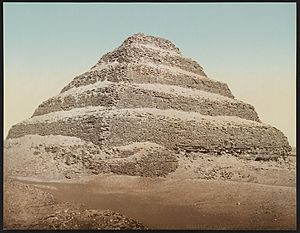Imhotep facts for kids
Quick facts for kids
Imhotep
|
|
|---|---|
| Ancient Egyptian: Jj m ḥtp | |

Statuette of Imhotep, c. 650 BC
|
|
| Burial place | Saqqara (probable) |
| Other names | Asclepius (name in Greek) Imouthes (also name in Greek) |
| Occupation | chancellor to the King Djoser and High Priest of Ra |
| Years active | c. 2625 BC |
| Known for | Being the architect of Djoser's step pyramid |
| Imhotep in hieroglyphs | ||||||
|---|---|---|---|---|---|---|
Imhotep Jj m ḥtp He who comes in peace |
||||||
Jj m ḥtp |
||||||
Jj m ḥtp |
||||||
| Greek Manetho variants: |
|
|||||
Imhotep (/ɪmˈhoʊtɛp/; Ancient Egyptian: ỉỉ-m-ḥtp meaning "(the one who) comes in peace") was an important figure in Ancient Egypt. He lived around 2625 BC. Imhotep served as a top advisor, called a chancellor, to King Djoser. He was also a high priest of the sun god Ra in the city of Heliopolis. Many historians believe he was the brilliant architect behind the famous Step Pyramid at Saqqara.
Even though we don't know much about Imhotep from his own time, he became incredibly famous and respected after his death. Over 3,000 years, people started to see him as a very wise person and a great doctor. However, no writings from his lifetime mention him as a physician or a writer. The first mentions of him appear about 1,200 years after he died.
Imhotep is one of only a few non-royal Egyptians who were honored as gods after they passed away. His main place of worship was in the city of Memphis. We still don't know where his tomb is, but many experts think it's hidden somewhere in Saqqara.
Contents
Imhotep's Life and Work
Imhotep's existence is confirmed by ancient writings from his time. His name appears on the base of a statue of King Djoser. It's also found on a wall near the unfinished pyramid of King Sekhemkhet. This suggests that Imhotep lived longer than Djoser and might have even worked on Sekhemkhet's pyramid before it was stopped.
Building the Step Pyramid
Imhotep was one of the most important officials working for Pharaoh Djoser. Many later stories and modern Egyptologists give him credit for designing and building the Pyramid of Djoser, which is a step pyramid located in Saqqara. This amazing structure was built during the 3rd Dynasty of Egypt.
He might also have been the first person known to use large stone columns to support a building. Before this, most buildings were made of mud bricks. Even though later generations praised him for these inventions, the ancient Egyptians themselves didn't write down that Imhotep was the inventor of stone architecture or the designer of the Step Pyramid. However, it was certainly a groundbreaking achievement for its time. Before Djoser, kings were usually buried in simpler tombs called mastabas.
Becoming a God
About 2,000 years after Imhotep died, his status grew from a respected person to a god of medicine and healing. Over time, he was even linked with Thoth, the Egyptian god of architecture, math, and writing. Imhotep's worship became part of Thoth's cult.
In the city of Thebes, people honored Imhotep as the "brother" of another deified architect named Amenhotep, son of Hapu. Because of his strong connection to health, the Greeks later connected Imhotep with their own god of healing, Asklepios. Asklepios was also a mortal who became a god.
According to some myths, Imhotep's mother was a mortal woman named Kheredu-ankh. She was also later seen as a minor goddess. Other stories say his mother was Sekhmet, the goddess of Upper Egypt, because Imhotep was sometimes called the "Son of Ptah," and Sekhmet was the partner of the god Ptah.
Imhotep's Influence in Later Times
A story from the Ptolemaic period (305–30 BC) tells about a great famine that lasted seven years during Djoser's rule. Imhotep is said to have played a key role in ending this famine. The story describes how one of Imhotep's priests explained to the Pharaoh the connection between the god Khnum and the rising of the Nile River. After this, the Pharaoh had a dream where the Nile god promised to end the drought.
A very old papyrus from the 2nd century AD tells a long story about Imhotep. In this story, King Djoser is important, and Imhotep's family is mentioned: his father, the god Ptah; his mother, Khereduankh; and his younger sister, Renpetneferet. This text even includes a magical battle where Imhotep fights an Assyrian sorceress.
Imhotep's respected image lasted for a very long time, even into the Roman period. The Egyptian historian Manetho (from the Ptolemaic period) gave Imhotep credit for inventing the method of building with cut stone during Djoser's reign. While some stone had been used before, a building as large and complex as the Step Pyramid, made entirely of stone, was truly a new achievement.
Medicine and Healing
While Imhotep was later seen as a god of medicine, some Egyptologists like James Peter Allen say there's no direct proof that Imhotep himself was a physician.
However, the oldest known written description of cancer comes from ancient Egyptian texts. The famous book The Emperor of All Maladies by Siddhartha Mukherjee mentions that Imhotep is credited with this early diagnosis. Sadly, the treatment Imhotep suggested for it was simple: "There is none." This shows how little was known about treating cancer in ancient times.
See also
 In Spanish: Imhotep para niños
In Spanish: Imhotep para niños
- Imhotep Museum
- History of ancient Egypt
- Ancient Egyptian architecture
- Ancient Egyptian medicine
- List of Egyptian Architects


